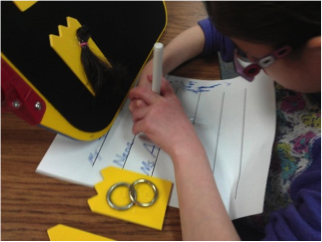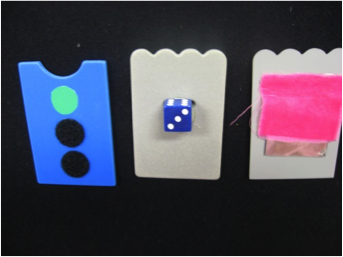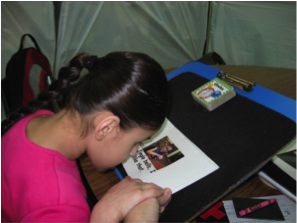Augmentative and Alternative Communication (AAC) Systems for Students with CVI & Multiple Disabilities
Submitted by Faye Gonzalez on Mar 16, 2015
Part 1: Partial-Object Symbols are MORE than Just a Schedule: Communication Systems for Students with CVI and Multiple Disabilities
The majority of Augmentative and Alternative Communication (AAC) systems available today use visually-based symbols. Often, however, students with multiple disabilities including visual impairments (MDVI) struggle with seeing and interpreting these two-dimensional, flat visual images. This is often due to MDVI students having Cortical Visual Impairment (CVI). For years, I wondered why it was that SOME children with CVI are able to understand these line-drawing based, flat symbols and others are not – until I read Dr. Roman-Lantzy’s book, “Cortical Visual Impairment: An Approach to Assessment and Intervention”. Dr. Roman-Lanzty states on page 134 that: “By the end of Phase II (CVI Range score of 7) the student will be able to use simple two-dimensional images”. My mental “light bulb” was suddenly flipped to ON – no wonder using these line drawings wasn’t working for many of my MDVI students with lower CVI Range scores! This highlights something we know but often don’t grasp the implications of: seeing something and interpreting & understanding an image are not the same thing. Frequently, a student who has MDVI might see objects and even try to look at pictures and line drawings, but this doesn’t mean that they UNDERSTAND what the flat image represents. Once I realized this, my next question was how DO I give these students access to a symbolic communication system despite the severity of their CVI? How do we support their communication needs despite their visual impairment?
3-Dimensional Symbols
 Working closely with other team members, we developed a 3-dimensional / partial object based system of symbols to support communication. It met the learning media criteria needed for my student who was a visual learner that struggled with auditory processing and had limited tactile skills. It met the language criteria needed for the student in that it allowed for the organization of language into different categories as is commonly used in many Communication/AAC systems. Categories used often include groups of words such as: questions, telling opinions, people, activities, places, what’s wrong, etc. Most importantly, this system used 3-dimensional symbols that were understandable to the student with CVI to represent language. We used the Tactile Connections Kit to create our symbols and the Symbols and Meaning Kit to support implementation of the system, both of which are available through APH.
Working closely with other team members, we developed a 3-dimensional / partial object based system of symbols to support communication. It met the learning media criteria needed for my student who was a visual learner that struggled with auditory processing and had limited tactile skills. It met the language criteria needed for the student in that it allowed for the organization of language into different categories as is commonly used in many Communication/AAC systems. Categories used often include groups of words such as: questions, telling opinions, people, activities, places, what’s wrong, etc. Most importantly, this system used 3-dimensional symbols that were understandable to the student with CVI to represent language. We used the Tactile Connections Kit to create our symbols and the Symbols and Meaning Kit to support implementation of the system, both of which are available through APH. Designing a Successful Symbol System
 The key to this system being successful is that we designed it to support communication and language needs, not just the student’s daily activities. It is very easy to make 3-D symbols for a daily schedule: a spoon represents lunch, a book is for reading, counting blocks for math, and so on. What was challenging however was designing symbols for words that are NOT object-based nouns, like happy, go, stop, mad, me, you, more, done.
The key to this system being successful is that we designed it to support communication and language needs, not just the student’s daily activities. It is very easy to make 3-D symbols for a daily schedule: a spoon represents lunch, a book is for reading, counting blocks for math, and so on. What was challenging however was designing symbols for words that are NOT object-based nouns, like happy, go, stop, mad, me, you, more, done.- We started by thinking about the language that the student needed to be able to say. We included words that we wanted her to say, words her peers would use, and most importantly words that the student herself wanted to say.
-
Next, we figured out how those words would be organized into different categories. The Tactile Connections Kit has 7 different colored & shaped cards, so we identified 7 groups of words that our student needed to access in order to be a successful communicator.
 We came up with: people (pronouns and proper nouns), things (objects), move (verbs), about (descriptors), places, time (calendar words and ordinal language), and talk (chat language and other common words).
We came up with: people (pronouns and proper nouns), things (objects), move (verbs), about (descriptors), places, time (calendar words and ordinal language), and talk (chat language and other common words).
- Then we designed the 3-dimensional symbols for each word needed, taking care to select partial-objects or 3-D images that would be meaningful to the student as well as easy to visually identify related to the student’s severe CVI needs. Occasionally we had to change a symbol because it was confusing or looked too much like another symbol.
- Slowly over time we taught this student the meaning of these symbols through active learning and play-based activities. We focused on the interaction between the student and her partner rather than on the symbols themselves, and immersed her in a language rich environment with lots of opportunities to see use of her symbols modeled by others.
Videos: Using Tactile Symbols in Play-Based Activities and Creating a Book with Tactile Symbols
Video 1: Using Tactile Symbols in Play-Based Activities
Video 2: Creating a Book with Tactile Symbols
Student Response to Symbols
The amazing thing is that this student learned the meaning of and understood these symbols! With instruction and practice, she was able to read them, use them to support her communication, and use them for writing. She was the most excited about the words/symbols related to feelings (from the “About” category) and words from the “People” category. Interestingly she had limited interest in using any of the words related to her schedule. If we would have only used 3-D symbols that were schedule-related, the system would not have been successful. During the process of learning how these symbols represent language, her speech became more intelligible as well, primarily because we used the same exact words over and over within her communication system. After a few years of trying so many different things that failed, we finally had a system that worked for this student. Ahhh, the sweet pictures of success!




Comments
AAC systems CVI
Suggestions regarding AAC devices for students with CVI